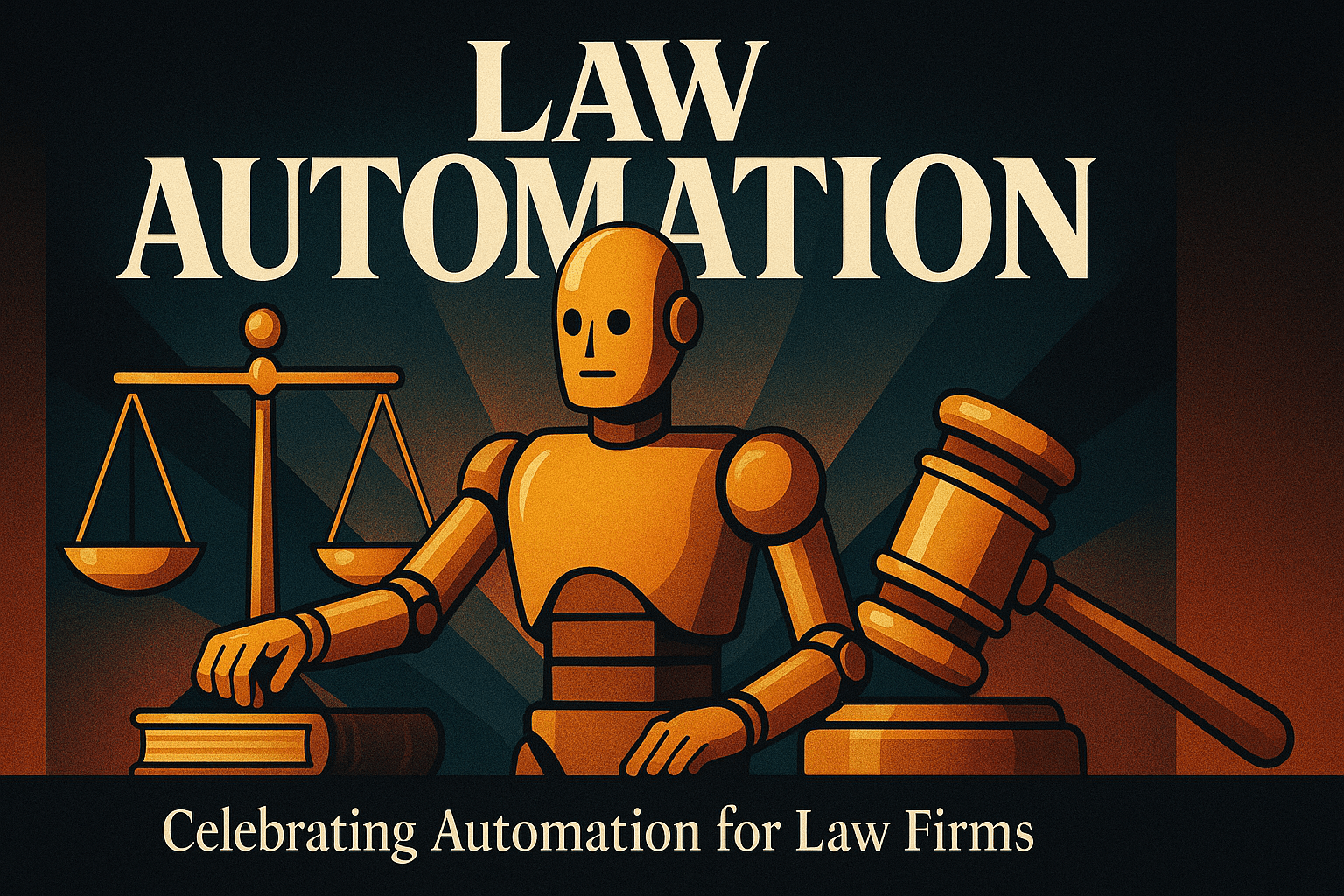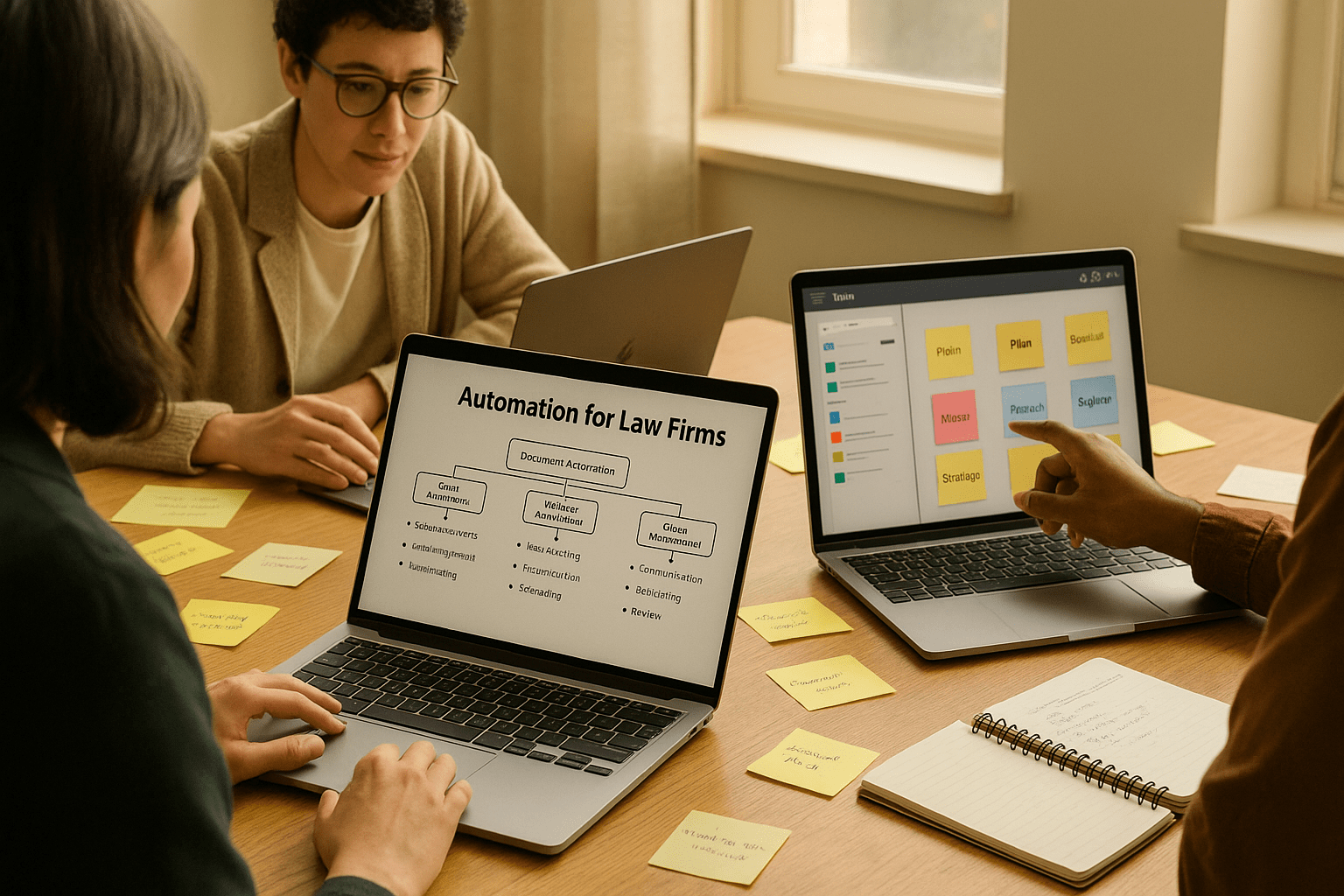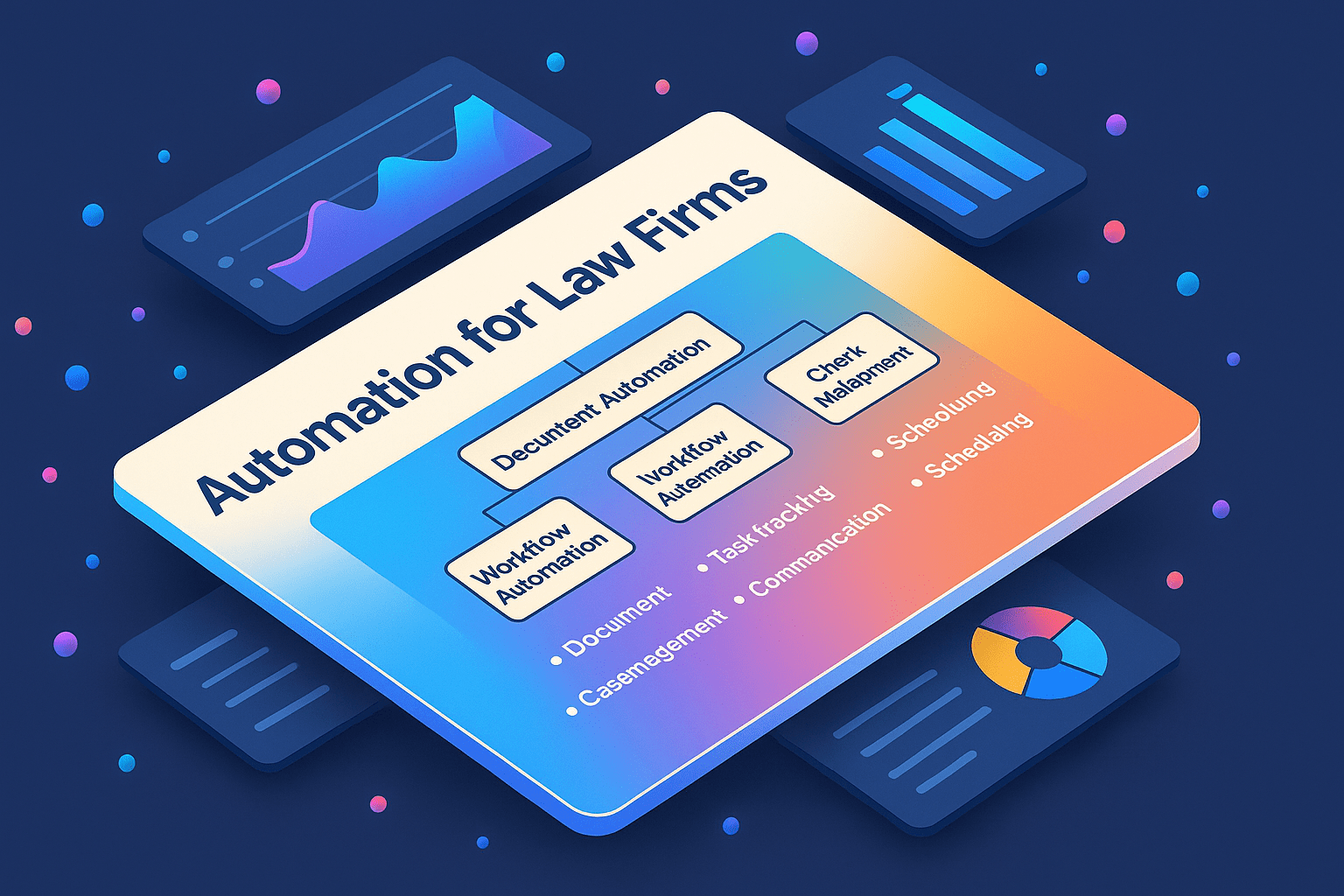Automation for Law Firms: A Strategic Guide to Streamlining Legal Operations and Maximizing Efficiency
by Design Delulu Editorial · October 14, 2025

Legal automation isn't about replacing lawyers—it's about eliminating the repetitive tasks that prevent talented legal professionals from focusing on high-value client work. In an industry where billable hours directly impact revenue, every minute spent on manual data entry, document assembly, or administrative coordination represents lost opportunity. Law firms that strategically implement automation are reclaiming 15-30% of their teams' time while simultaneously reducing errors, improving client satisfaction, and creating competitive advantages in an increasingly digital legal marketplace.
The financial case for automation extends beyond time savings. Modern law firms face mounting pressure from clients demanding transparency, predictable pricing, and faster turnarounds. Manual processes create bottlenecks that frustrate clients and strain internal resources. Meanwhile, forward-thinking firms are using automation to scale their practices without proportionally scaling headcount, achieving margins that seemed impossible just five years ago. Whether you're a solo practitioner or managing a multi-office firm, automation represents the fastest path to sustainable growth and operational excellence in today's legal environment.

Why Law Firms Need Automation Now
The legal industry stands at a critical inflection point. Client expectations have fundamentally shifted—they expect the same digital experience from their law firm that they receive from their bank, healthcare provider, or favorite retailer. Yet many firms still rely on processes designed for a pre-digital era: manual timekeeping, paper-based document management, email chains for client communications, and spreadsheets for matter tracking.
This operational gap creates three urgent challenges. First, talent retention suffers when skilled attorneys and paralegals spend hours on administrative work rather than meaningful legal analysis. Second, client satisfaction erodes when simple requests take days instead of minutes. Third, profitability stagnates because manual processes don't scale—adding more clients means adding more staff, limiting growth potential.
Forward-thinking law firms are addressing these challenges with targeted automation. They're not implementing technology for technology's sake; they're strategically eliminating friction points that prevent growth. The firms winning new business are those that can provide instant case status updates, generate engagement letters in minutes rather than days, and respond to client questions with data-driven insights pulled from centralized systems.
Consider the typical client intake process. Without automation, a potential client fills out a form, someone manually enters that data into multiple systems, conflicts checks happen via email chains, engagement letters are drafted from scratch, and initial consultations are scheduled through back-and-forth phone calls. This process can take 3-5 days and touch six different people. With automation, the same process completes in under an hour with a single staff member reviewing automated outputs. That time savings multiplies across every new matter, creating capacity for substantial practice growth.
High-Impact Automation Opportunities for Law Firms
Not all automation delivers equal value. The most successful law firm automation strategies focus on processes that are high-volume, time-consuming, error-prone, or client-facing. These areas offer the fastest return on investment and the most immediate operational improvements.
Client Intake and Onboarding
First impressions matter enormously in legal services. Automating client intake transforms a traditionally slow, manual process into a streamlined experience that impresses prospects while reducing administrative burden. Key automation opportunities include:
- Digital intake forms with conditional logic that adapt questions based on case type, collecting comprehensive information in a single session
- Automated conflicts checking that cross-references new clients against existing and past matters, flagging potential issues instantly
- Electronic engagement letters with digital signature capabilities, eliminating printing, mailing, and manual filing
- Automated scheduling that integrates with attorney calendars, allowing prospects to book consultations without phone tag
- Payment processing setup that collects retainers and establishes billing automatically upon engagement
These automations reduce intake time from days to hours while ensuring no critical information falls through the cracks. Clients appreciate the professional, efficient experience, and staff can focus on relationship-building rather than data entry.
Document Assembly and Management
Legal documents follow predictable patterns, making them ideal candidates for automation. Document assembly systems can generate contracts, pleadings, correspondence, and agreements in minutes rather than hours, pulling client and matter data from centralized systems to populate templates automatically.
Beyond initial creation, automated document management ensures files are properly named, tagged, saved to correct matter folders, and accessible to appropriate team members. Version control happens automatically, eliminating confusion about which draft is current. Automated workflows can route documents for review, approval, and signature without manual coordination.
The productivity gains are substantial. A document that previously required 45 minutes of attorney time (finding the right template, manually filling in details, formatting, proofreading) now takes 5 minutes. Multiply this across dozens of documents per week, and the time savings become transformative.
Billing and Time Tracking
Billing represents one of the most universally painful processes in law firms. Manual timekeeping is notorious for lost billable hours—studies suggest attorneys fail to capture 10-20% of their time due to delays in recording activities. Automated time tracking captures work in real-time, using triggers like email activity, document editing, and calendar events to suggest time entries.
Automation also streamlines the billing process itself:
- Automated invoice generation pulls time entries and expenses at billing cycle close, creating professional invoices without manual compilation
- Electronic payment processing allows clients to pay invoices online with a single click, improving collection speed
- Payment reminders automatically notify clients of upcoming and overdue balances, reducing accounts receivable aging
- Trust accounting automation ensures compliance with complex rules around client funds while reducing manual reconciliation work
These improvements directly impact cash flow and profitability while reducing the administrative burden on legal staff.
Client Communication and Updates
Clients frequently cite poor communication as their primary complaint about legal services. Automation addresses this by ensuring consistent, timely updates without requiring attorney intervention for routine communications.
Automated communication systems can send case status updates, hearing reminders, document request follow-ups, and milestone notifications based on matter progress. Client portals provide 24/7 access to case information, documents, and billing details, reducing inbound calls and emails requesting updates.
Strategic automation also enhances relationship management through scheduled check-ins, satisfaction surveys, and referral requests at appropriate matter stages. These touchpoints strengthen client relationships and generate new business opportunities without adding to staff workload.

Building Your Law Firm Automation Strategy
Successful automation requires strategic planning rather than ad-hoc tool adoption. The firms that achieve the best results follow a structured approach that prioritizes high-impact opportunities, ensures stakeholder buy-in, and creates sustainable systems for ongoing optimization.
Step 1: Process Audit and Prioritization
Begin by documenting your current workflows in detail. Map out each step of key processes like client intake, document production, billing cycles, and matter management. Identify pain points where work gets delayed, errors occur frequently, or staff express frustration. Track how much time each process requires and how often it repeats.
With this baseline understanding, prioritize automation opportunities using three criteria:
- Volume: How frequently does this process occur? High-frequency activities deliver faster ROI
- Time investment: How many person-hours does this process consume monthly? Higher time investments justify more sophisticated automation
- Error rate: How often do mistakes occur, and what are the consequences? Error-prone processes benefit enormously from automation's consistency
Create a prioritized list ranking automation opportunities by potential impact. Focus your initial efforts on the top three to five items rather than attempting to automate everything simultaneously.
Step 2: Technology Selection and Integration
Modern law firms can choose from specialized legal practice management platforms that offer integrated automation capabilities, or they can connect best-of-breed tools through integration platforms. The right approach depends on your firm's size, practice areas, and technical sophistication.
Integrated practice management platforms like Clio, MyCase, or PracticePanther provide automation for time tracking, billing, client communications, and document management within a single system. This approach simplifies implementation and reduces integration complexity, making it ideal for small to mid-size firms.
Specialized automation tools offer deeper capabilities in specific areas. Document automation platforms like HotDocs or Contract Express provide more sophisticated template logic. Marketing automation tools like Lawmatics focus specifically on intake and business development. Integration platforms like Zapier or Make (formerly Integromat) can connect these specialized tools with your core systems.
When evaluating options, prioritize tools that offer robust APIs and integration capabilities. Siloed systems that don't share data create new inefficiencies rather than solving existing ones. Look for solutions with strong user communities, regular updates, and responsive support.
Step 3: Implementation and Change Management
Technology implementation fails most often due to poor change management rather than technical issues. Build your rollout plan with these principles in mind:
- Start with champions: Identify enthusiastic early adopters who will test new workflows and provide feedback before firm-wide deployment
- Provide comprehensive training: Don't assume tools are intuitive—invest in hands-on training sessions and create reference materials for ongoing support
- Establish clear accountability: Assign specific team members to own each automated process and serve as go-to resources
- Set adoption metrics: Track usage of new systems and follow up with team members who aren't engaging
- Gather feedback continuously: Create channels for staff to report issues, suggest improvements, and share successes
Phase your implementation rather than switching everything at once. Deploy one or two processes, ensure they're working smoothly, then move to the next priorities. This measured approach builds confidence and allows for course correction.
Step 4: Measurement and Optimization
Automation isn't a set-it-and-forget-it solution—it requires ongoing measurement and refinement. Establish baseline metrics before implementation, then track improvements:
- Time savings: How much faster do automated processes complete compared to manual alternatives?
- Error reduction: How have mistake rates changed in automated workflows?
- Cost impact: What are the hard dollar savings from reduced staff time and error correction?
- Client satisfaction: Have client experience metrics improved since implementing automation?
- Revenue impact: Has automation enabled new business growth or improved realization rates?
Schedule quarterly reviews of your automation systems. Look for processes that aren't delivering expected benefits and identify why. Often, minor adjustments to workflows or additional training can dramatically improve results. Conversely, celebrate and document successes to build momentum for additional automation initiatives.
Common Automation Pitfalls and How to Avoid Them
While automation offers tremendous benefits, firms that rush implementation without proper planning often encounter obstacles. Understanding common pitfalls helps you avoid them.
Over-Automating Too Quickly
The temptation to automate everything simultaneously creates confusion and resistance. Staff become overwhelmed learning multiple new systems, leading to poor adoption and frustration. Instead, implement automation incrementally, ensuring each new system is working well before adding the next.
Automating Broken Processes
Automation amplifies whatever process you feed it—if your current workflow is inefficient or illogical, automation will simply make you inefficient faster. Before automating, optimize your process design. Eliminate unnecessary steps, clarify decision points, and ensure the workflow makes sense. Then automate the improved process.
Neglecting Data Quality
Automated systems depend on clean, consistent data. If your client database contains duplicate records, missing information, or inconsistent formatting, automation will propagate these issues throughout your systems. Invest time in data cleanup before implementation, then establish data entry standards to maintain quality.
Ignoring Security and Compliance
Legal automation must respect attorney-client privilege, protect sensitive information, and comply with ethical rules around client data. When implementing automation, ensure tools meet security standards, understand where data is stored, review data sharing agreements, and establish access controls. Your state bar's technology guidelines should inform your security approach.
Insufficient Training and Support
Even the best automation tools fail without proper training. Budget adequate time and resources for comprehensive initial training, ongoing education as systems evolve, documentation that staff can reference independently, and accessible support when questions arise. Consider appointing internal technology champions who receive advanced training and support their colleagues.

Measuring Automation ROI in Legal Practice
Automation requires investment in software, implementation, and training. Firms naturally want to understand the return on that investment. While some benefits are immediately quantifiable, others manifest over time through improved capacity, client retention, and competitive positioning.
Direct Financial Returns
The most straightforward ROI calculation compares time savings against implementation costs. If automation reduces 20 hours of paralegal work weekly, that's over 1,000 hours annually. At $50 per hour, that represents $50,000 in annual savings. Compare this to typical automation software costs of $5,000-15,000 annually, and the ROI becomes clear within the first year.
Additional direct financial benefits include improved billing realization through better time capture, faster collections due to streamlined billing and payment processing, reduced overhead from decreased paper, postage, and storage costs, and error reduction that eliminates costly mistakes and malpractice risks.
Capacity and Growth Metrics
Beyond immediate cost savings, automation creates capacity for growth. Track how automation impacts your ability to handle more matters with existing staff, reduce the time from lead to client conversion, respond faster to client requests and inquiries, and take on new practice areas or service offerings.
Many firms find that automation is the key to profitable growth—it allows them to scale revenue without proportionally scaling headcount, maintaining or improving margins as the practice expands.
Client Experience Improvements
Satisfied clients return for future matters and provide referrals—the most cost-effective business development channel. While harder to quantify precisely, automation-driven client experience improvements deliver substantial long-term value. Monitor client satisfaction scores before and after automation, referral rates from existing clients, online review ratings and frequency, client retention across multiple matters, and unsolicited positive feedback or testimonials.
Even modest improvements in these metrics compound significantly over time, generating new business that far exceeds initial automation investments.
Future-Proofing Your Law Firm with Automation
The legal industry's technology adoption curve is accelerating. What seemed cutting-edge five years ago is now table stakes, and firms that delay automation risk falling behind competitors who are building increasingly efficient operations.
The most successful firms view automation not as a one-time project but as an ongoing strategic priority. They cultivate cultures of continuous improvement, regularly evaluating new tools and approaches. They invest in training to ensure teams can leverage automation effectively. They measure results and refine their approaches based on data.
Importantly, they recognize that automation enhances rather than replaces legal expertise. The goal isn't to eliminate attorneys—it's to eliminate the administrative burden that prevents attorneys from focusing on high-value legal work. Firms that embrace this philosophy create environments where talented legal professionals can do their best work, serve clients more effectively, and build sustainable, profitable practices.
As artificial intelligence continues advancing, legal automation will only become more sophisticated. Forward-thinking firms are positioning themselves now to leverage these emerging capabilities, building strong foundational automation systems that can incorporate AI enhancements as they mature. The competitive advantages available to automation-savvy firms will only grow in coming years.
Getting Started: Your Automation Roadmap
If you're ready to begin automating your law firm, follow this practical roadmap:
Month 1: Assessment and Planning
- Document your current workflows in detail for key processes
- Survey staff about pain points and opportunities for improvement
- Identify your top three automation priorities based on impact potential
- Research technology solutions that address your priority areas
- Establish baseline metrics you'll use to measure success
Month 2: Tool Selection and Preparation
- Request demos and trials from your shortlisted technology providers
- Evaluate options against your specific requirements and budget
- Select your tools and complete the procurement process
- Clean and prepare data that will feed your automated systems
- Identify your implementation team and automation champions
Month 3: Implementation and Training
- Configure your selected tools to match your optimized workflows
- Conduct thorough testing with a small group before broad deployment
- Provide comprehensive training for all users
- Create documentation and reference materials
- Launch your first automated process to a pilot group
Month 4+: Optimization and Expansion
- Gather feedback from users and make necessary adjustments
- Measure results against your baseline metrics
- Expand successful automations firm-wide
- Begin planning your next automation priorities
- Establish a regular cadence for reviewing and improving systems
This timeline provides a realistic framework for initial automation implementation. Some firms move faster, particularly if they have dedicated project management resources. Others need more time, especially larger firms with complex approval processes. The key is maintaining momentum and celebrating wins along the way.
Conclusion: The Competitive Imperative of Law Firm Automation
Automation is no longer a luxury or a competitive differentiator—it's rapidly becoming a necessity for law firms that want to remain competitive. Clients expect efficient, technology-enabled service. Talented legal professionals want to work in environments that respect their time and expertise. Profitability requires operational efficiency that manual processes simply cannot deliver.
The firms that will thrive in the next decade are those embracing automation strategically today. They're making the investments in technology, training, and process improvement that create compounding advantages over time. They're building practices that can scale sustainably, serve clients exceptionally, and provide rewarding work environments for their teams.
The question isn't whether your firm should automate—it's how quickly you can implement automation effectively. Start with your highest-impact opportunities, measure your results, refine your approach, and expand systematically. The efficiency gains, client satisfaction improvements, and competitive advantages you build will define your firm's trajectory for years to come.
Frequently Asked Questions
Let’s level up your Law Firms business
Need services that actually move the needle for Law Firms? See our approach, pricing, and timelines—then book a quick call.
Additional Resources
- Schedule Your Automation Strategy Consultation
Book a complimentary 30-minute consultation to discuss your firm's automation opportunities. We'll review your current workflows, identify high-impact automation priorities, and outline a customized implementation roadmap tailored to your practice areas and growth goals.
- View Our Law Firm Automation Portfolio
Explore real-world examples of automation implementations across various practice areas. See case studies, before-and-after workflows, and measurable results from firms that have transformed their operations through strategic automation.
- Access Free Law Firm Automation Tools
Download free resources including automation readiness assessments, workflow documentation templates, ROI calculators, technology comparison guides, and implementation checklists. Start evaluating your automation opportunities with proven frameworks used by successful law firms.
Related Reading

Discover how automation for electricians streamlines scheduling, invoicing, lead tracking, and customer follow-ups to boost revenue and efficiency. Get started today.

Discover how automation streamlines furniture & home decor operations with GA4 tracking, attribution modeling, and data-driven dashboards. Get your 90-day implementation roadmap.
